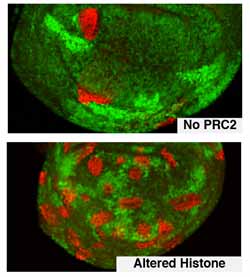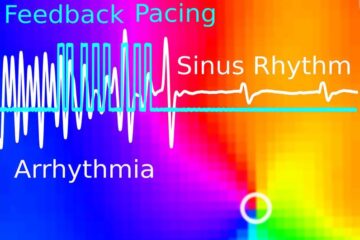Histone Modification Controls Development

Cells lacking PRC2 (top) or cells containing an altered histone that can no longer be tagged (bottom) show the same effect: a gene that normally should be shut down, is activated (red signal). As opposed to the surrounding wild type cells marked with green.<br><br>Figure: Ana R. Pengelly/ Copyright: MPI of Biochemistry<br>
Scientists of the MPI Biochemistry have now established that adding chemical tags on histones is critical for regulating gene activity during animal development. Former studies revealed that many proteins that control gene activity are enzymes that add small chemical tags on histones but also on a variety of other proteins. With their studies the scientists have now shown that it is the tags on the histones that control if genes are active or not.
Histone proteins can be modified by a number of different chemical tags at very specific sites. The researchers in the Research Group ‘Chromatin Biology’ of Jürg Müller focused on the histone tag that is added by an enzyme called Polycomb Repressive Complex 2 (PRC2). PRC2 is essential for a variety of different cell fate decisions in animals and plants. PRC2 functions to keep genes inactive in cells and at times where they should remain inactive.
Using the model organism Drosophila – the fruit fly – the scientists now generated animals with cells expressing an altered histone protein to which PRC2 can no longer add the tag. These cells cannot keep genes inactive anymore and many cell fate decisions go awry, exactly like in cells that lack the PRC2 enzyme. “This observation demonstrates that the business end is the tag on the histone and not on some other protein” says Ana Pengelly, the PhD student who conducted the experiments.
Her colleague Omer Copur adds: “The approach we used permits us to now also investigate the function of other tags on histone proteins that have a different chemical nature.” The insight gained from the work on PRC2 provides a strong impetus to figure how this tag alters the beads-on-a-string structure of genes and thereby controls gene activity.
Media Contact
All latest news from the category: Life Sciences and Chemistry
Articles and reports from the Life Sciences and chemistry area deal with applied and basic research into modern biology, chemistry and human medicine.
Valuable information can be found on a range of life sciences fields including bacteriology, biochemistry, bionics, bioinformatics, biophysics, biotechnology, genetics, geobotany, human biology, marine biology, microbiology, molecular biology, cellular biology, zoology, bioinorganic chemistry, microchemistry and environmental chemistry.
Newest articles

Wildfire danger to increase due to climate change
WSL Institute for Snow and Avalanche Research (SLF) researchers expect an elevated wildfire danger in the Alpine Foreland from 2040 onwards due to changing meteorological conditions. The danger currently remains…

Advanced Brain Science Without Coding Expertise
Researchers at Helmholtz Munich and the LMU University Hospital Munich introduce DELiVR, offering a new AI-based approach to the complex task of brain cell mapping. The deep learning tool democratizes…

Gentle defibrillation for the heart
Using light pulses as a model for electrical defibrillation, Göttingen scientists developed a method to assess and modulate the heart function. The research team from the Max Planck Institute for…





















